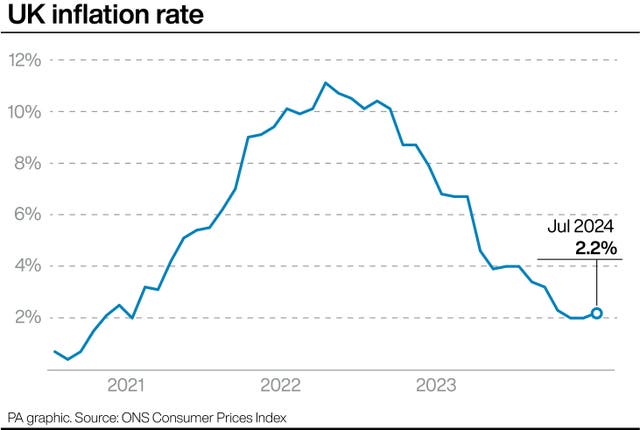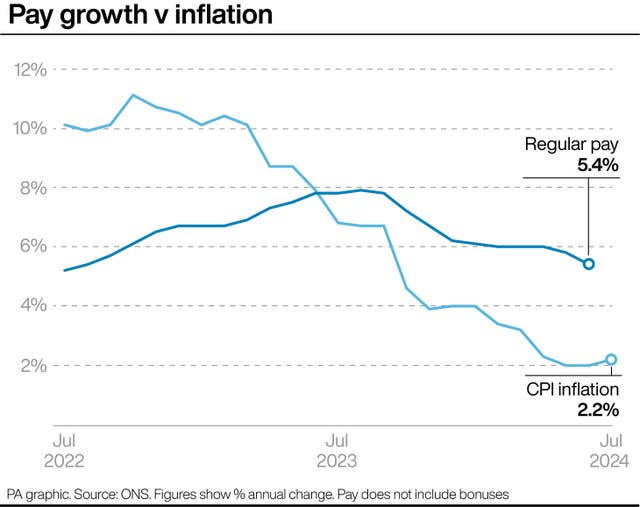Inflation climbs above Bank of England target in first rise of 2024
While inflation hit 2.2% in June, signs of easing pressure in the services sector fuelled hopes of more rate cuts by the Bank.

Inflation has risen for the first time this year, but signs of easing price pressures in key areas like the services sector have given economists hope of further Bank of England interest rate cuts.
The Office for National Statistics (ONS) said the UK’s overall measure of inflation, the Consumer Prices Index (CPI), rose to 2.2% in July, up from 2% in June.
The latest figures mean that prices are rising faster across the country than in previous months, but still at a slower rate than in 2022 and 2023 when households and businesses were being squeezed during the peak of the cost crisis.
While it represents the first time inflation has climbed since December, most economists had predicted a sharper rise, driven by a drop-off in the effect of falling energy bills on this month’s figures.
That drop-off still happened. Grant Fitzner, chief economist at the ONS, said: “Inflation ticked up a little in July as although domestic energy costs fell, they fell by less than a year ago.”
However, inflation in the services sector – things like hospitality and culture – provided a welcome surprise, slowing to 5.2% for the year to July, down from 5.7% the previous month and more than expected. The slowdown came from a sharp drop in hotel prices between June and July.
Bank of England policymakers watch services inflation closely when trying to figure out how much domestic prices are rising. So far this year, it has remained stubbornly high compared to other parts of the economy.

The sharp drop in this area last month has led some economists to predict more interest rate cuts by the Bank, after the Monetary Policy Committee made a quarter point reduction to 5% earlier this month.
And it comes after the ONS revealed on Tuesday that wage growth, another key indicator for the Bank, was 5.4% year on year over the three months to June, down from 5.7% in the previous three months.
Sanjay Raja, chief UK economist at Deutsche Bank Research, said: “A September rate cut should no longer be off the table. And it’s entirely conceivable to think that we could get multiple more rate cuts this year.”
Others said this month’s falls on their own will not be enough to tempt policymakers into cutting rates next month, partly because officials expect overall inflation will continue to nudge up for the rest of 2024 before falling gradually again.
Sarah Coles, head of personal finance at Hargreaves Lansdown said it is still “likely to be business as usual at the Bank in September, with rates on hold”.
Luke Bartholomew, deputy chief economist at fund manager Abrdn, added: “After yesterday’s solid labour market report, the Bank will not be in any hurry to cut rates again immediately, but the ongoing slowing in inflation pressure means there is certainly scope for at least one more rate cut this year.”
Elsewhere, the rate of inflation for alcohol and tobacco prices was still high at 7.2% in July, down slightly from 7.3% in June. The rate for other food and drink remained stable at 1.5%.
The retail prices index (RPI), which measures a representative group of retail goods and services, was 3.6% for July.

The July RPI inflation rate has historically been used as the base for train ticket price rises for the following year, though it was not used in 2022 or 2023 because inflation was unusually high.
The CPIH, a measure of inflation which includes owner-occupiers’ housing costs, rose by 3.1% in the 12 months to July, up from 2.8% in June.
Lalitha Try, economist at the Resolution Foundation, said: “The first rise in inflation in seven months may sound like bad news, but in fact the small size of the increase – and the sharp fall in services inflation that lies behind it – is good news for both consumers and policy makers.
“The price of domestic services such as restaurants and leisure activities have replaced food and energy bills as the focus of price pressures – for now at least. Keeping a lid on these price rises will hold the key to keeping overall inflation close to target, and getting interest rates down.”





